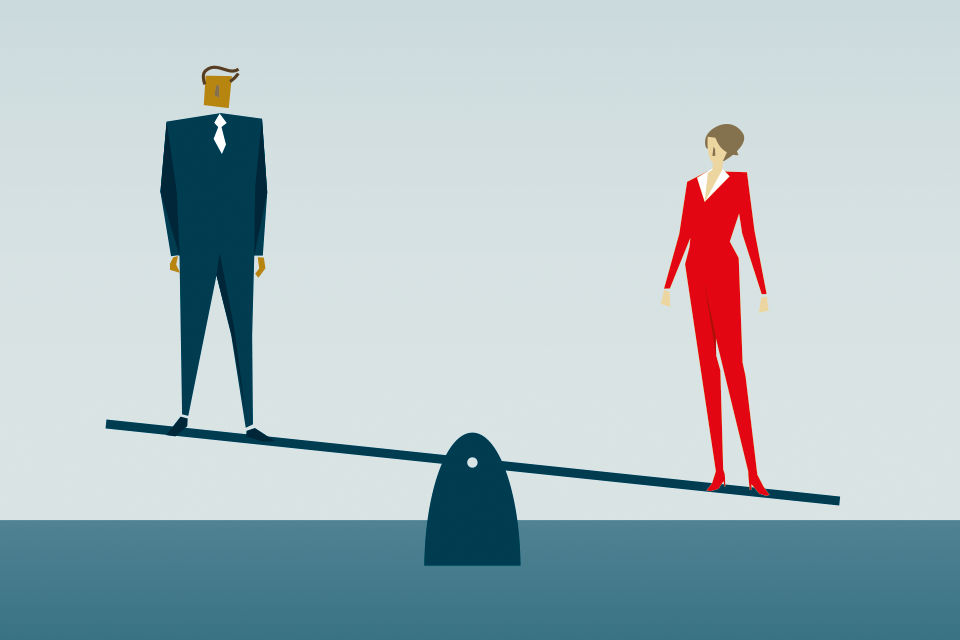
Pay gaps and pay equality between the sexes have been much in the news recently. And rightly so.
The Civil Service has been leading the way for a number of years by publishing gender pay gap information as part of the annual Civil Service statistics.
As of today, 17 ministerial departments with more than 250 employees have also complied with the Government’s new reporting requirements, introduced this year, for large employers in all sectors. This is world-leading legislation that will make workplaces across the UK fairer. The new requirements will provide unprecedented transparency, generate wider debate and encourage employers to take the action required to close the gap.
I am pleased to say that the overall Civil Service gender pay gap has narrowed over the past year, from 13.6% in 2016 to 12.7% in 2017. The gender pay gap for the public sector as a whole is now 19.4%, compared to 23.7% in the private sector.
That said, our gender pay gap is still a matter of concern. In particular, we need to focus on improving the gender balance at all grades and across all departments, agencies, functions and professions. For example, though we have made steady improvements in the last few years in the representation of women in the Senior Civil Service (SCS) and at Grades 6 and 7 (the proportion of SCS who are women is now 42.4%, an increase of 9.8 percentage points since 2008; and, in 2016/17, 49% of new entrants to the SCS were women), representation at these grades is still not what it should be.
As I’ve said before, building a diverse and inclusive workforce that reflects the people we serve is one of my top priorities as Head of the Civil Service. Our collective aim is to make the Civil Service the UK’s most inclusive employer by 2020.

In October, we launched our new Diversity and Inclusion Strategy in October, outlining plans for achieving this aim and setting out how we will continue to improve the gender balance of the Civil Service at all levels, including in the most senior posts. I want to create opportunity for all, in a truly meritocratic way, and reward all civil servants fairly, regardless of gender, ethnicity or any other personal characteristic.
We have been working towards this in a number of ways.
We have published guidance on diverse panels to limit the impact of unconscious bias in selection; and we have virtually eliminated all-male selection panels for posts at SCS level. We are also ensuring recruiters for the Civil Service focus harder on attraction and fair selection, to deliver a diverse candidate shortlist. The Civil Service must become more visible as a career of choice, and we are working to promote experience in a challenging post in the Civil Service as an essential part of a senior leader’s career portfolio.
With an eye on the future, we have taken action to improve the diversity of our talent programmes to make us more representative at the most senior grades. In response to the independent 2016 Bridge Group Report, which addressed diversity in the Fast Stream, we are working to ensure that this flagship accelerated development programme quickly becomes more representative of the wider population. Likewise, we continue to work hard to deliver representative intakes to our prestigious Future Leaders and Senior Leaders schemes. These have a huge part to play in creating a more diverse and representative Senior Civil Service.
We are conscious of the impact particular male-dominated job roles in professions such as digital, data and technology could have on the pay gap. Currently, only 36% of civil servants working in the digital, data and technology profession are women. We know that the UK’s pay gap is partly driven by the subject and career choices young people make at school, but also by social, economic and cultural factors. The Government Equalities Office is looking at what can be done about this at a national level. Functional leaders within the Civil Service are also looking at methods that can be used to attract candidates from a range of backgrounds.
A final and key part of attracting diverse candidates to the Civil Service is through promoting an inclusive culture where everyone can be themselves, perform at their best and be fairly rewarded as part of ‘A Brilliant Civil Service’
One way we are doing this is by developing a family-friendly employment offer, through the continued availability of shared parental leave and a range of other parental leave support. At present, nearly a quarter of all civil servants work part- time. I have seen that in areas such as the government legal profession, many civil servants have been attracted by the steps we are taking to ensure that there is a place for everyone in the Civil Service. Steps such as improving availability of flexible, home working, and job-share opportunities, including at the most senior levels.
Recently, the Government launched new ‘returner’ programmes across the public sector. These will offer paid work placements and training to those returning after time out for caring. According to the Institute for Fiscal Studies, women who take time out of work earn around 2% less for every year spent out of paid work.
 As today’s gender pay publications show, there is much more to do. The Civil Service Diversity and Inclusion Strategy has set out further clear actions to achieve representative diversity. We must all embrace the strategy and think about what we can do to make the Civil Service a truly great place to work for everyone.
As today’s gender pay publications show, there is much more to do. The Civil Service Diversity and Inclusion Strategy has set out further clear actions to achieve representative diversity. We must all embrace the strategy and think about what we can do to make the Civil Service a truly great place to work for everyone.
Follow Sir Jeremy on Twitter: @HeadUKCivServ.

9 comments
Comment by Si posted on
The wage gap from what i've seen online and on a well known online video provider is not so much a gap of like for like doing the same job but was a more a general slice of data that did not take into account like life style choices/preferances and it seemed that the bigger issue was the lack of opportunities for women to get into positions that are higher waged, managerial etc.
I found 'The factual feminist' amongst others on said video provider to be enlightning in this matter.
A gap does exist and im sure in some places men are paid more for the same but there are undelying reasons for this more than the data alone seems to initialy show.
The big wage gap as already mentioned here, seems to be from department to deparment that affects all genders.
Comment by James posted on
I like everyone else would support any move to remove unfair pay inequality. If two people are doing the same job to the same level then they should be paid the same.
The report includes many reasons that may explain the gender pay gap including the data showing there are a higher proportion of males in higher grades and specialist roles so I have no idea how a level of comparison can truly be made until that changes. The fairness of recruitment and promotion is critical but a different subject.
I would like to see a report focusing on pay gaps across departments and in grades that results in a real drive to end staff in the same grade, doing the same job in the same or different department with a pay variation of 25 plus %.
Once this has been rectified then surely a gender pay gap review would generate valid results?
This simply indicates that out 10 SCS, 7 are male and 3 are female and we want it to be 50/50 or 51/49 to genuinely reflect the population.
The best line manager I have had was female so I hope I do not come across as not supporting this, I just think we are still missing/avoiding general pay gaps in the civil service.
If there are 100 SEOs 75 are male, 25 are female, should we recruit 50 more female SEOs to narrow the gap? The 50 would then be at the bottom of the pay scale earning considerably less than the 12.7 variant indicated in this report compared to those who have been in post before 2010.
Comment by Anon posted on
The pay gap is being made worse by the removal of pay progression and the complete and utter failure to replace it with performance related pay or any ability to progress through the spans. Until this is resolved there will be no meaningful change to the pay gap.
I know I'm not being paid less than my colleagues simply because I'm female but I am being paid less than them because in my department middle and senior level female staff tend to be younger and more recently promoted and therefore not benefited from automatic pay progression.
How can it be anything than unequal pay to have two people doing the same job with one being on substantially less money with basically no way of catching up ?
Comment by John posted on
The only pay gap that seems to be narrowing is the one between staff wages and the minimum wage threshold!!
Comment by John posted on
The only pay gap that is currently narrowing is the one between staff wages and the minimum wage threshold!!
Comment by p posted on
I believe it has actually been against the law since 1970 to have a gender pay gap. Someone starting work that year could be retired by now and there is still gender inequality!
The problem with pay progression is equally bad as instead of progressing to the proper rate for the job by climbing the band we are rapidly falling to the rate of new starters at the bottom of the scale whilst being patronised that we are doing a superb job.
I find it incredulous that civil service jobs are advertised with a pay band at all as there is no way to clinb the greasy ladder.
Comment by Claudia Wootten posted on
Rather sad that the title of this blog is Narrowing the Gender Pay Gap which kind of implys we are ok with having a gap but we’d just like it to be a little narrower. Where is the ambition to remove the gap? If private sector organisations can remove the gap we should except the same from the Civil Service. Women in the Civil Service need to keep fighting the good fight
Comment by c posted on
If we're talking about pay equality then can we please talk about the lack of pay progression meaning some people are paid less than the people sat next to them doing exactly the same job.
Comment by Anon posted on
From my experience, within the civil service there is an overwhelming expectation that the mother provides the care. My husband has to fight much harder than me to be afforded time to provide care to our children. The expectation should never be that a father should automatically look to his partner to provide care for their children, but it is the expectation of his manager.
Just recently I over heard colleagues discussing how terrible a female colleague was because she expected her husband to collect their children from school. The feeling was because his grade way higher than hers that she should do it, he was being walked over by his wife and should be allowed to focus on his career as the main earner. Perhaps his wife is focusing on her career, perhaps her role isn’t as flexible as his, perhaps she drops off and therefore they are sharing the load equally, perhaps he wants to do it, perhaps she would like to do it but her job wont allow it.
Parenting does not fall to the mother/woman. Fathers are as important in a child’s upbringing and a women’s career/job is as important as a mans, neither should be expected to focus on one more prominently due to their gender.
Attitudes have changed a lot but I think there is still a way to go. Treating parents equally would go some way to addressing this.